Evaluating Financial Health: Ratios and Accounting in Business Finance
VerifiedAdded on 2023/06/11
|10
|3369
|251
Report
AI Summary
This report provides an overview of business finance and economics, focusing on the internal and external determinants of business performance. It elaborates on the role and importance of accounting in decision-making within a corporation, highlighting how accounting practices and data collection aid in strategic planning and operational efficiency. The report discusses different financial statements, including the statement of financial position (balance sheet) and income statement, explaining key terms and their significance. It includes the calculation and interpretation of various financial ratios for XYZ plc, such as operating profit margin, gross profit margin, current ratio, and acid test ratio, to assess the company's profitability and liquidity. The report also defines management accounting and its importance in providing information for internal decision-making, cost control, and performance evaluation. The analysis concludes by emphasizing the critical role of financial management in ensuring business sustainability and growth.

Business Finance and
Economics
Economics
Paraphrase This Document
Need a fresh take? Get an instant paraphrase of this document with our AI Paraphraser
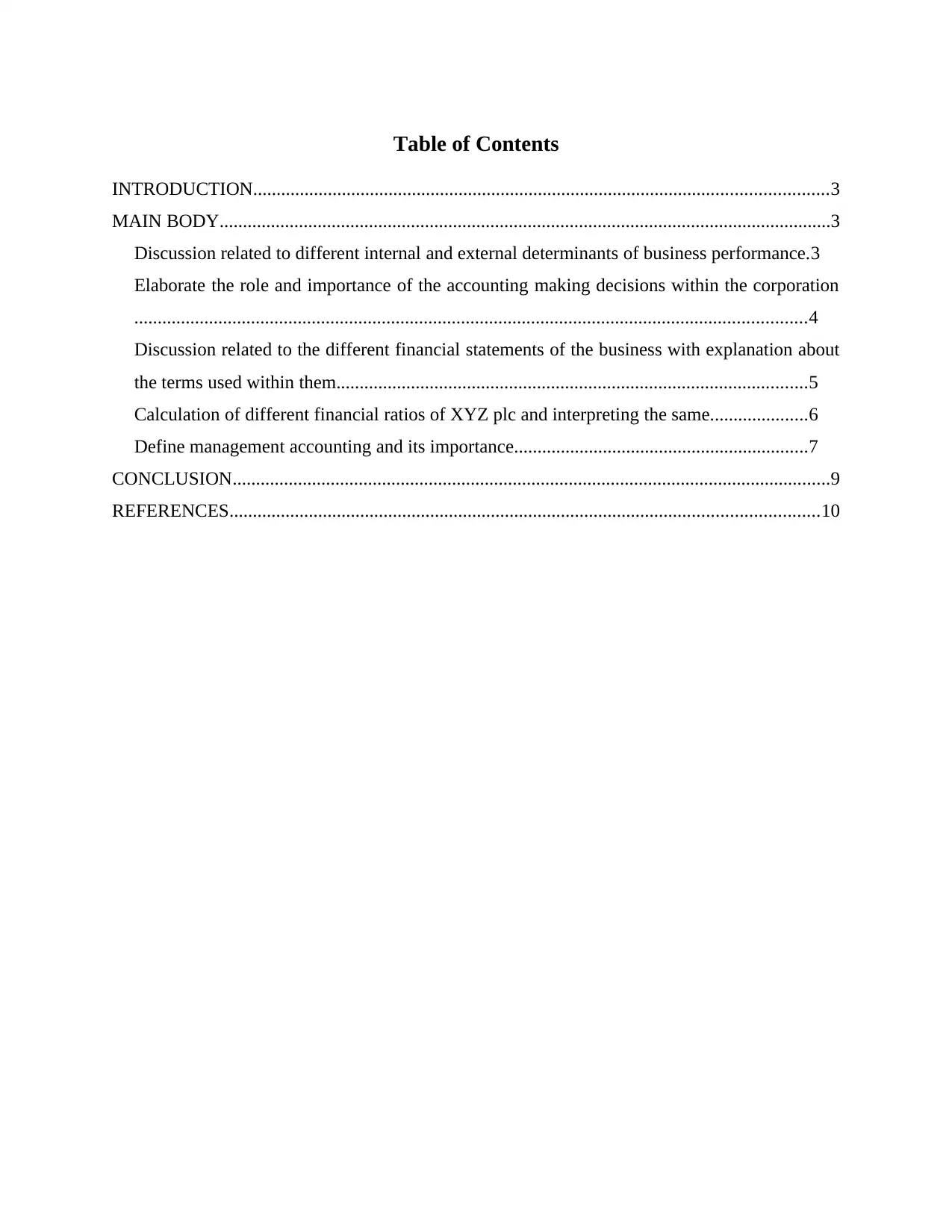
Table of Contents
INTRODUCTION...........................................................................................................................3
MAIN BODY...................................................................................................................................3
Discussion related to different internal and external determinants of business performance.3
Elaborate the role and importance of the accounting making decisions within the corporation
................................................................................................................................................4
Discussion related to the different financial statements of the business with explanation about
the terms used within them.....................................................................................................5
Calculation of different financial ratios of XYZ plc and interpreting the same.....................6
Define management accounting and its importance...............................................................7
CONCLUSION................................................................................................................................9
REFERENCES..............................................................................................................................10
INTRODUCTION...........................................................................................................................3
MAIN BODY...................................................................................................................................3
Discussion related to different internal and external determinants of business performance.3
Elaborate the role and importance of the accounting making decisions within the corporation
................................................................................................................................................4
Discussion related to the different financial statements of the business with explanation about
the terms used within them.....................................................................................................5
Calculation of different financial ratios of XYZ plc and interpreting the same.....................6
Define management accounting and its importance...............................................................7
CONCLUSION................................................................................................................................9
REFERENCES..............................................................................................................................10
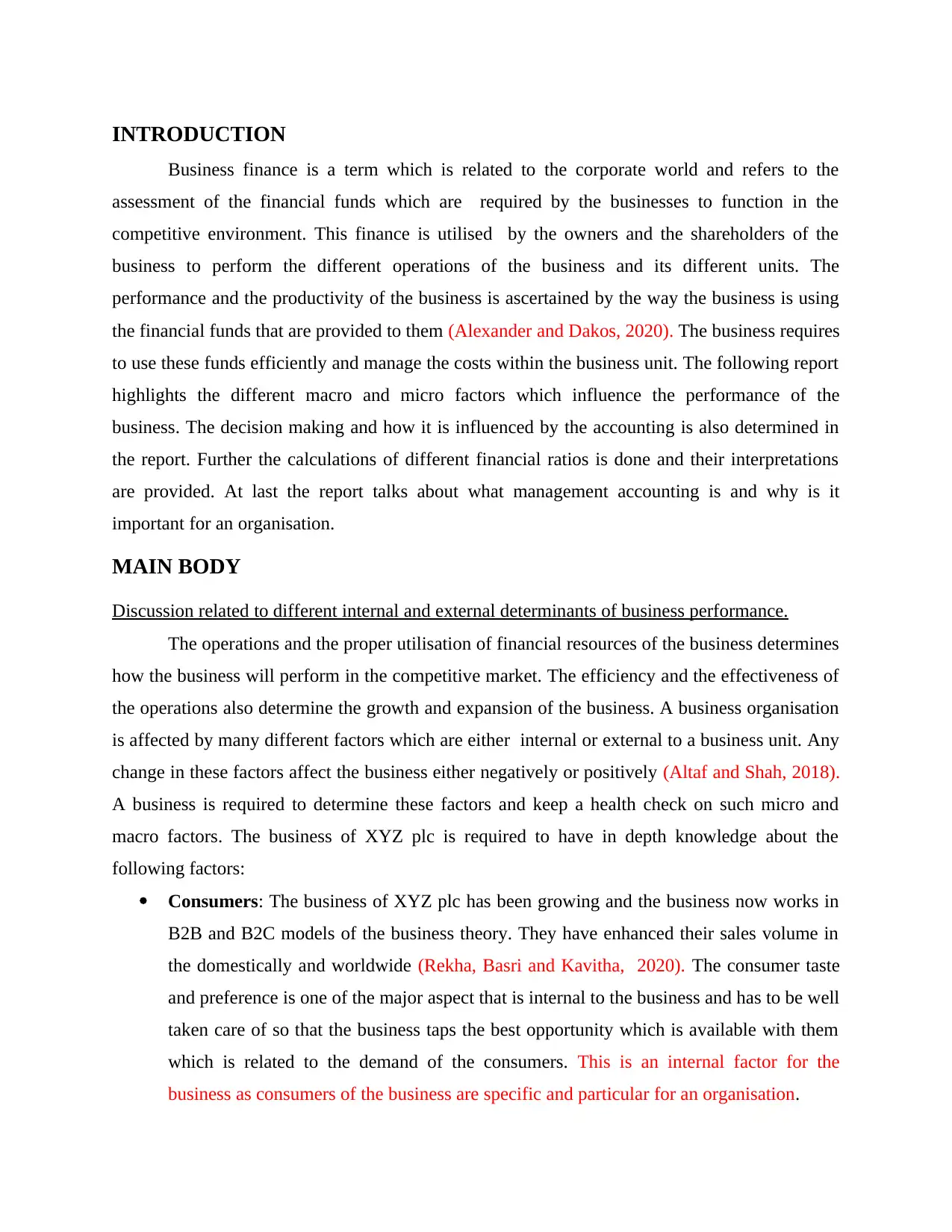
INTRODUCTION
Business finance is a term which is related to the corporate world and refers to the
assessment of the financial funds which are required by the businesses to function in the
competitive environment. This finance is utilised by the owners and the shareholders of the
business to perform the different operations of the business and its different units. The
performance and the productivity of the business is ascertained by the way the business is using
the financial funds that are provided to them (Alexander and Dakos, 2020). The business requires
to use these funds efficiently and manage the costs within the business unit. The following report
highlights the different macro and micro factors which influence the performance of the
business. The decision making and how it is influenced by the accounting is also determined in
the report. Further the calculations of different financial ratios is done and their interpretations
are provided. At last the report talks about what management accounting is and why is it
important for an organisation.
MAIN BODY
Discussion related to different internal and external determinants of business performance.
The operations and the proper utilisation of financial resources of the business determines
how the business will perform in the competitive market. The efficiency and the effectiveness of
the operations also determine the growth and expansion of the business. A business organisation
is affected by many different factors which are either internal or external to a business unit. Any
change in these factors affect the business either negatively or positively (Altaf and Shah, 2018).
A business is required to determine these factors and keep a health check on such micro and
macro factors. The business of XYZ plc is required to have in depth knowledge about the
following factors:
Consumers: The business of XYZ plc has been growing and the business now works in
B2B and B2C models of the business theory. They have enhanced their sales volume in
the domestically and worldwide (Rekha, Basri and Kavitha, 2020). The consumer taste
and preference is one of the major aspect that is internal to the business and has to be well
taken care of so that the business taps the best opportunity which is available with them
which is related to the demand of the consumers. This is an internal factor for the
business as consumers of the business are specific and particular for an organisation.
Business finance is a term which is related to the corporate world and refers to the
assessment of the financial funds which are required by the businesses to function in the
competitive environment. This finance is utilised by the owners and the shareholders of the
business to perform the different operations of the business and its different units. The
performance and the productivity of the business is ascertained by the way the business is using
the financial funds that are provided to them (Alexander and Dakos, 2020). The business requires
to use these funds efficiently and manage the costs within the business unit. The following report
highlights the different macro and micro factors which influence the performance of the
business. The decision making and how it is influenced by the accounting is also determined in
the report. Further the calculations of different financial ratios is done and their interpretations
are provided. At last the report talks about what management accounting is and why is it
important for an organisation.
MAIN BODY
Discussion related to different internal and external determinants of business performance.
The operations and the proper utilisation of financial resources of the business determines
how the business will perform in the competitive market. The efficiency and the effectiveness of
the operations also determine the growth and expansion of the business. A business organisation
is affected by many different factors which are either internal or external to a business unit. Any
change in these factors affect the business either negatively or positively (Altaf and Shah, 2018).
A business is required to determine these factors and keep a health check on such micro and
macro factors. The business of XYZ plc is required to have in depth knowledge about the
following factors:
Consumers: The business of XYZ plc has been growing and the business now works in
B2B and B2C models of the business theory. They have enhanced their sales volume in
the domestically and worldwide (Rekha, Basri and Kavitha, 2020). The consumer taste
and preference is one of the major aspect that is internal to the business and has to be well
taken care of so that the business taps the best opportunity which is available with them
which is related to the demand of the consumers. This is an internal factor for the
business as consumers of the business are specific and particular for an organisation.
⊘ This is a preview!⊘
Do you want full access?
Subscribe today to unlock all pages.

Trusted by 1+ million students worldwide
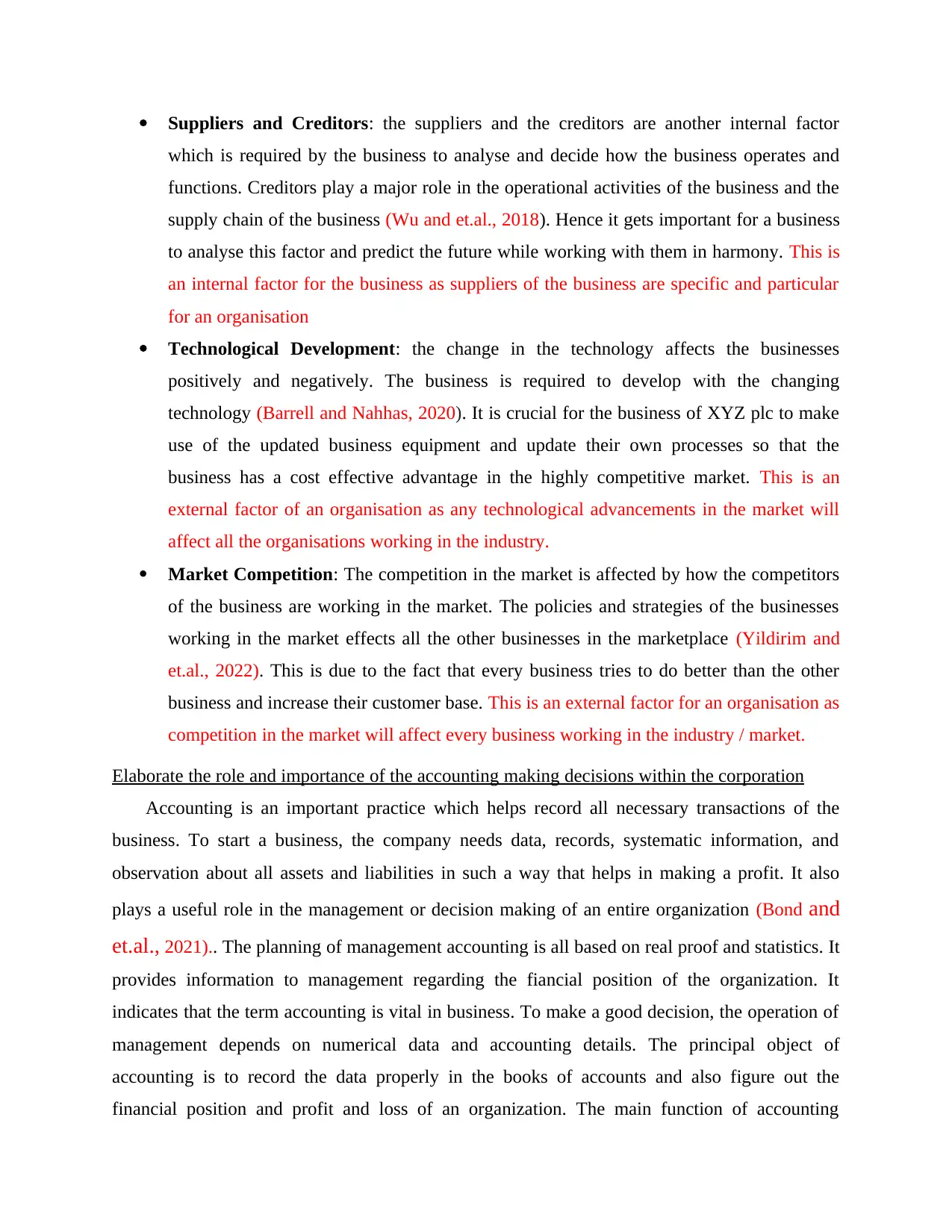
Suppliers and Creditors: the suppliers and the creditors are another internal factor
which is required by the business to analyse and decide how the business operates and
functions. Creditors play a major role in the operational activities of the business and the
supply chain of the business (Wu and et.al., 2018). Hence it gets important for a business
to analyse this factor and predict the future while working with them in harmony. This is
an internal factor for the business as suppliers of the business are specific and particular
for an organisation
Technological Development: the change in the technology affects the businesses
positively and negatively. The business is required to develop with the changing
technology (Barrell and Nahhas, 2020). It is crucial for the business of XYZ plc to make
use of the updated business equipment and update their own processes so that the
business has a cost effective advantage in the highly competitive market. This is an
external factor of an organisation as any technological advancements in the market will
affect all the organisations working in the industry.
Market Competition: The competition in the market is affected by how the competitors
of the business are working in the market. The policies and strategies of the businesses
working in the market effects all the other businesses in the marketplace (Yildirim and
et.al., 2022). This is due to the fact that every business tries to do better than the other
business and increase their customer base. This is an external factor for an organisation as
competition in the market will affect every business working in the industry / market.
Elaborate the role and importance of the accounting making decisions within the corporation
Accounting is an important practice which helps record all necessary transactions of the
business. To start a business, the company needs data, records, systematic information, and
observation about all assets and liabilities in such a way that helps in making a profit. It also
plays a useful role in the management or decision making of an entire organization (Bond and
et.al., 2021).. The planning of management accounting is all based on real proof and statistics. It
provides information to management regarding the fiancial position of the organization. It
indicates that the term accounting is vital in business. To make a good decision, the operation of
management depends on numerical data and accounting details. The principal object of
accounting is to record the data properly in the books of accounts and also figure out the
financial position and profit and loss of an organization. The main function of accounting
which is required by the business to analyse and decide how the business operates and
functions. Creditors play a major role in the operational activities of the business and the
supply chain of the business (Wu and et.al., 2018). Hence it gets important for a business
to analyse this factor and predict the future while working with them in harmony. This is
an internal factor for the business as suppliers of the business are specific and particular
for an organisation
Technological Development: the change in the technology affects the businesses
positively and negatively. The business is required to develop with the changing
technology (Barrell and Nahhas, 2020). It is crucial for the business of XYZ plc to make
use of the updated business equipment and update their own processes so that the
business has a cost effective advantage in the highly competitive market. This is an
external factor of an organisation as any technological advancements in the market will
affect all the organisations working in the industry.
Market Competition: The competition in the market is affected by how the competitors
of the business are working in the market. The policies and strategies of the businesses
working in the market effects all the other businesses in the marketplace (Yildirim and
et.al., 2022). This is due to the fact that every business tries to do better than the other
business and increase their customer base. This is an external factor for an organisation as
competition in the market will affect every business working in the industry / market.
Elaborate the role and importance of the accounting making decisions within the corporation
Accounting is an important practice which helps record all necessary transactions of the
business. To start a business, the company needs data, records, systematic information, and
observation about all assets and liabilities in such a way that helps in making a profit. It also
plays a useful role in the management or decision making of an entire organization (Bond and
et.al., 2021).. The planning of management accounting is all based on real proof and statistics. It
provides information to management regarding the fiancial position of the organization. It
indicates that the term accounting is vital in business. To make a good decision, the operation of
management depends on numerical data and accounting details. The principal object of
accounting is to record the data properly in the books of accounts and also figure out the
financial position and profit and loss of an organization. The main function of accounting
Paraphrase This Document
Need a fresh take? Get an instant paraphrase of this document with our AI Paraphraser
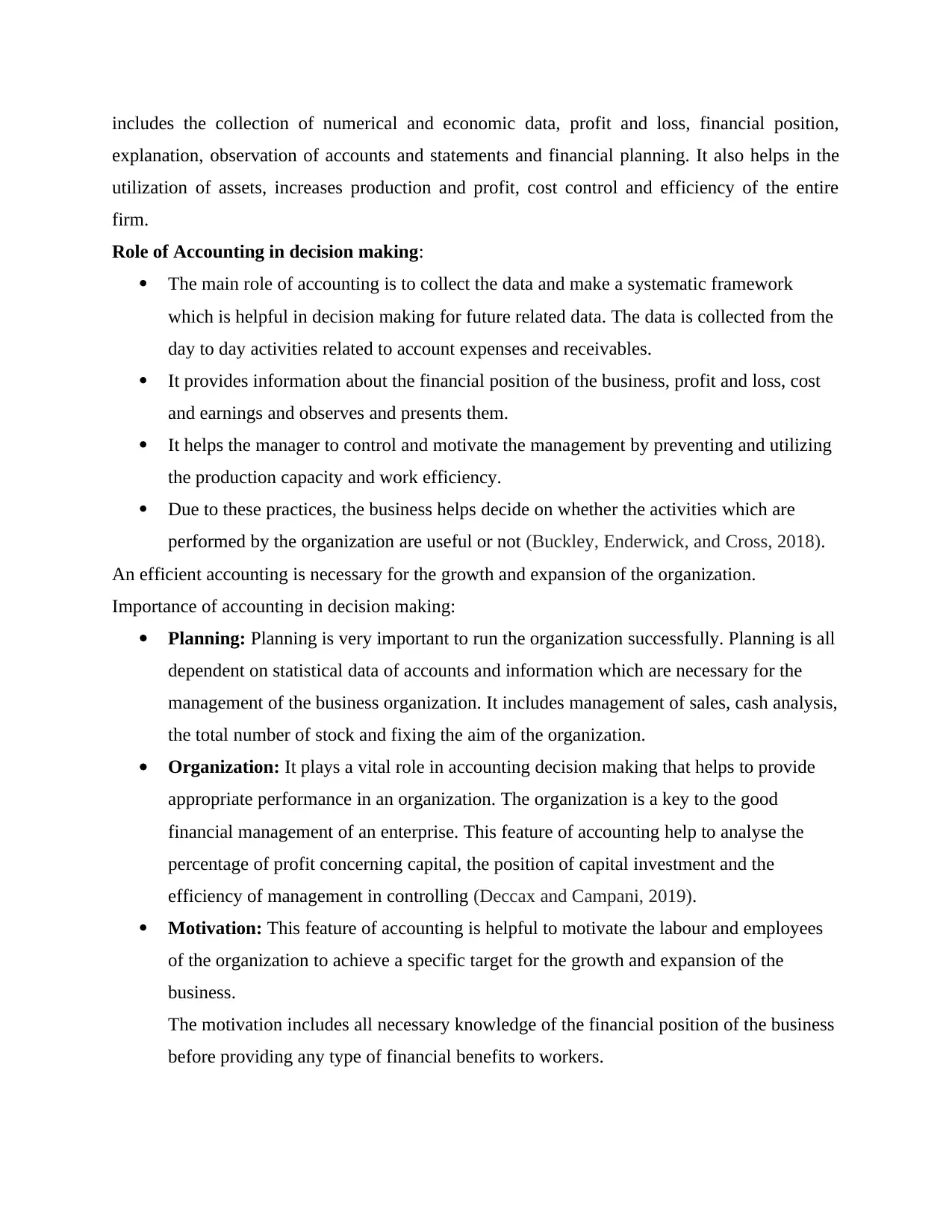
includes the collection of numerical and economic data, profit and loss, financial position,
explanation, observation of accounts and statements and financial planning. It also helps in the
utilization of assets, increases production and profit, cost control and efficiency of the entire
firm.
Role of Accounting in decision making:
The main role of accounting is to collect the data and make a systematic framework
which is helpful in decision making for future related data. The data is collected from the
day to day activities related to account expenses and receivables.
It provides information about the financial position of the business, profit and loss, cost
and earnings and observes and presents them.
It helps the manager to control and motivate the management by preventing and utilizing
the production capacity and work efficiency.
Due to these practices, the business helps decide on whether the activities which are
performed by the organization are useful or not (Buckley, Enderwick, and Cross, 2018).
An efficient accounting is necessary for the growth and expansion of the organization.
Importance of accounting in decision making:
Planning: Planning is very important to run the organization successfully. Planning is all
dependent on statistical data of accounts and information which are necessary for the
management of the business organization. It includes management of sales, cash analysis,
the total number of stock and fixing the aim of the organization.
Organization: It plays a vital role in accounting decision making that helps to provide
appropriate performance in an organization. The organization is a key to the good
financial management of an enterprise. This feature of accounting help to analyse the
percentage of profit concerning capital, the position of capital investment and the
efficiency of management in controlling (Deccax and Campani, 2019).
Motivation: This feature of accounting is helpful to motivate the labour and employees
of the organization to achieve a specific target for the growth and expansion of the
business.
The motivation includes all necessary knowledge of the financial position of the business
before providing any type of financial benefits to workers.
explanation, observation of accounts and statements and financial planning. It also helps in the
utilization of assets, increases production and profit, cost control and efficiency of the entire
firm.
Role of Accounting in decision making:
The main role of accounting is to collect the data and make a systematic framework
which is helpful in decision making for future related data. The data is collected from the
day to day activities related to account expenses and receivables.
It provides information about the financial position of the business, profit and loss, cost
and earnings and observes and presents them.
It helps the manager to control and motivate the management by preventing and utilizing
the production capacity and work efficiency.
Due to these practices, the business helps decide on whether the activities which are
performed by the organization are useful or not (Buckley, Enderwick, and Cross, 2018).
An efficient accounting is necessary for the growth and expansion of the organization.
Importance of accounting in decision making:
Planning: Planning is very important to run the organization successfully. Planning is all
dependent on statistical data of accounts and information which are necessary for the
management of the business organization. It includes management of sales, cash analysis,
the total number of stock and fixing the aim of the organization.
Organization: It plays a vital role in accounting decision making that helps to provide
appropriate performance in an organization. The organization is a key to the good
financial management of an enterprise. This feature of accounting help to analyse the
percentage of profit concerning capital, the position of capital investment and the
efficiency of management in controlling (Deccax and Campani, 2019).
Motivation: This feature of accounting is helpful to motivate the labour and employees
of the organization to achieve a specific target for the growth and expansion of the
business.
The motivation includes all necessary knowledge of the financial position of the business
before providing any type of financial benefits to workers.
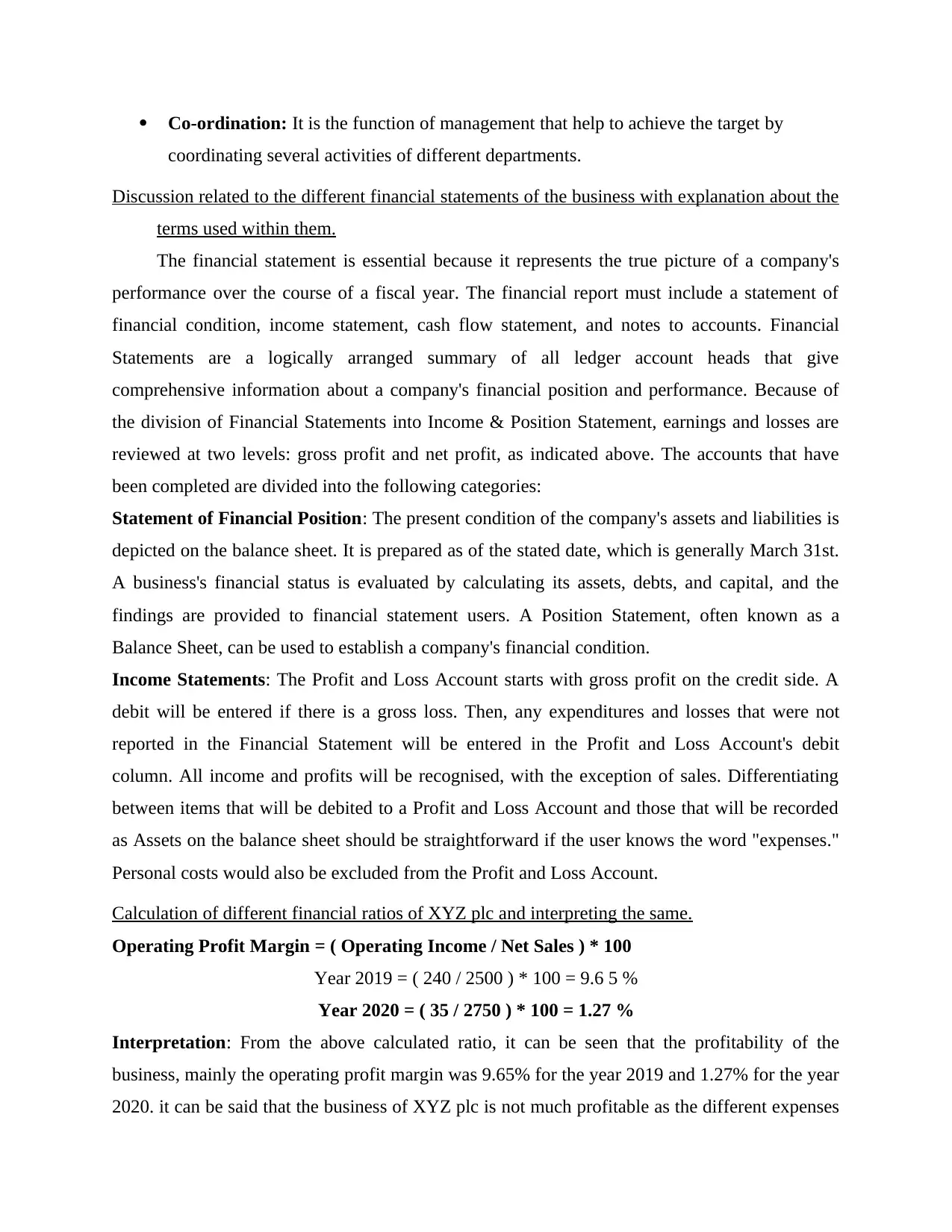
Co-ordination: It is the function of management that help to achieve the target by
coordinating several activities of different departments.
Discussion related to the different financial statements of the business with explanation about the
terms used within them.
The financial statement is essential because it represents the true picture of a company's
performance over the course of a fiscal year. The financial report must include a statement of
financial condition, income statement, cash flow statement, and notes to accounts. Financial
Statements are a logically arranged summary of all ledger account heads that give
comprehensive information about a company's financial position and performance. Because of
the division of Financial Statements into Income & Position Statement, earnings and losses are
reviewed at two levels: gross profit and net profit, as indicated above. The accounts that have
been completed are divided into the following categories:
Statement of Financial Position: The present condition of the company's assets and liabilities is
depicted on the balance sheet. It is prepared as of the stated date, which is generally March 31st.
A business's financial status is evaluated by calculating its assets, debts, and capital, and the
findings are provided to financial statement users. A Position Statement, often known as a
Balance Sheet, can be used to establish a company's financial condition.
Income Statements: The Profit and Loss Account starts with gross profit on the credit side. A
debit will be entered if there is a gross loss. Then, any expenditures and losses that were not
reported in the Financial Statement will be entered in the Profit and Loss Account's debit
column. All income and profits will be recognised, with the exception of sales. Differentiating
between items that will be debited to a Profit and Loss Account and those that will be recorded
as Assets on the balance sheet should be straightforward if the user knows the word "expenses."
Personal costs would also be excluded from the Profit and Loss Account.
Calculation of different financial ratios of XYZ plc and interpreting the same.
Operating Profit Margin = ( Operating Income / Net Sales ) * 100
Year 2019 = ( 240 / 2500 ) * 100 = 9.6 5 %
Year 2020 = ( 35 / 2750 ) * 100 = 1.27 %
Interpretation: From the above calculated ratio, it can be seen that the profitability of the
business, mainly the operating profit margin was 9.65% for the year 2019 and 1.27% for the year
2020. it can be said that the business of XYZ plc is not much profitable as the different expenses
coordinating several activities of different departments.
Discussion related to the different financial statements of the business with explanation about the
terms used within them.
The financial statement is essential because it represents the true picture of a company's
performance over the course of a fiscal year. The financial report must include a statement of
financial condition, income statement, cash flow statement, and notes to accounts. Financial
Statements are a logically arranged summary of all ledger account heads that give
comprehensive information about a company's financial position and performance. Because of
the division of Financial Statements into Income & Position Statement, earnings and losses are
reviewed at two levels: gross profit and net profit, as indicated above. The accounts that have
been completed are divided into the following categories:
Statement of Financial Position: The present condition of the company's assets and liabilities is
depicted on the balance sheet. It is prepared as of the stated date, which is generally March 31st.
A business's financial status is evaluated by calculating its assets, debts, and capital, and the
findings are provided to financial statement users. A Position Statement, often known as a
Balance Sheet, can be used to establish a company's financial condition.
Income Statements: The Profit and Loss Account starts with gross profit on the credit side. A
debit will be entered if there is a gross loss. Then, any expenditures and losses that were not
reported in the Financial Statement will be entered in the Profit and Loss Account's debit
column. All income and profits will be recognised, with the exception of sales. Differentiating
between items that will be debited to a Profit and Loss Account and those that will be recorded
as Assets on the balance sheet should be straightforward if the user knows the word "expenses."
Personal costs would also be excluded from the Profit and Loss Account.
Calculation of different financial ratios of XYZ plc and interpreting the same.
Operating Profit Margin = ( Operating Income / Net Sales ) * 100
Year 2019 = ( 240 / 2500 ) * 100 = 9.6 5 %
Year 2020 = ( 35 / 2750 ) * 100 = 1.27 %
Interpretation: From the above calculated ratio, it can be seen that the profitability of the
business, mainly the operating profit margin was 9.65% for the year 2019 and 1.27% for the year
2020. it can be said that the business of XYZ plc is not much profitable as the different expenses
⊘ This is a preview!⊘
Do you want full access?
Subscribe today to unlock all pages.

Trusted by 1+ million students worldwide
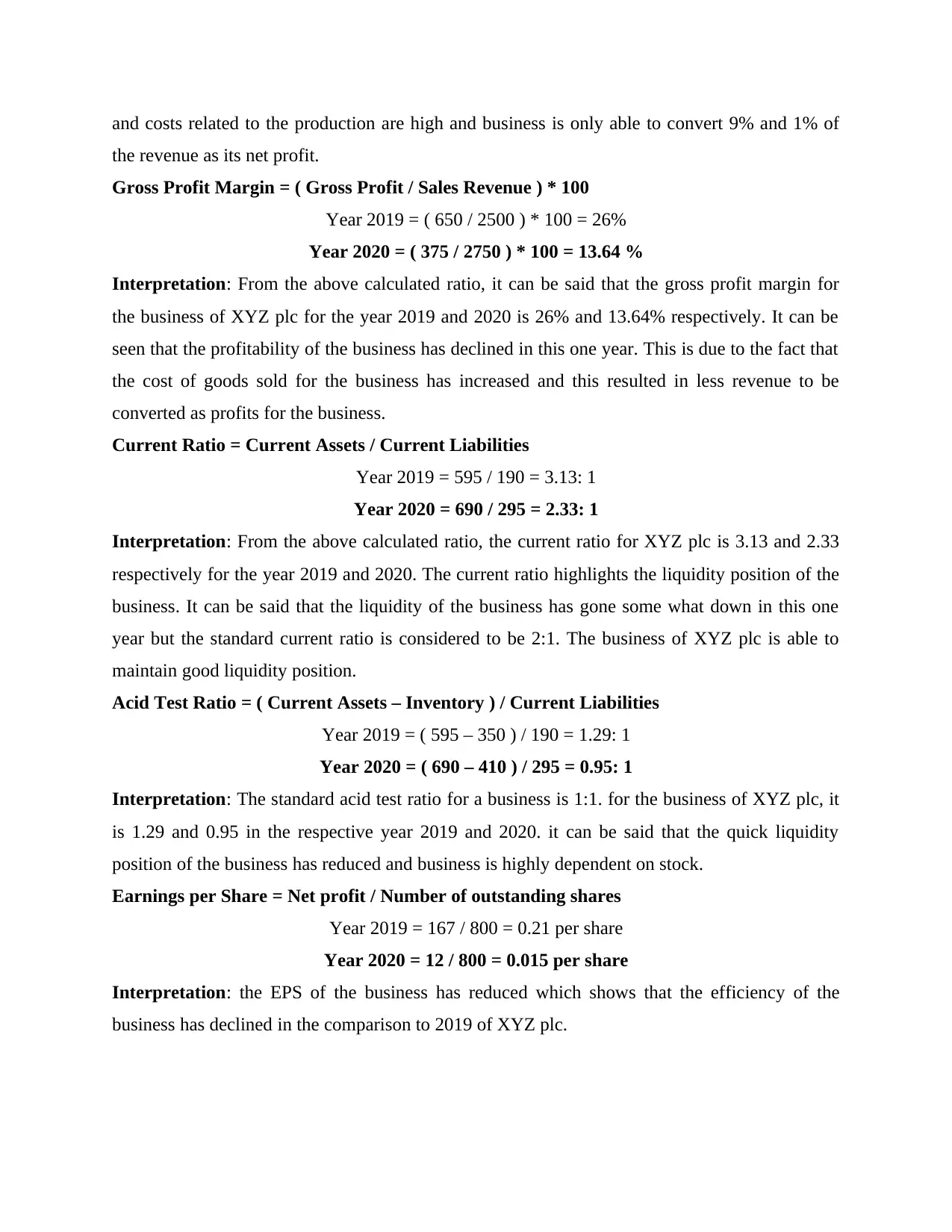
and costs related to the production are high and business is only able to convert 9% and 1% of
the revenue as its net profit.
Gross Profit Margin = ( Gross Profit / Sales Revenue ) * 100
Year 2019 = ( 650 / 2500 ) * 100 = 26%
Year 2020 = ( 375 / 2750 ) * 100 = 13.64 %
Interpretation: From the above calculated ratio, it can be said that the gross profit margin for
the business of XYZ plc for the year 2019 and 2020 is 26% and 13.64% respectively. It can be
seen that the profitability of the business has declined in this one year. This is due to the fact that
the cost of goods sold for the business has increased and this resulted in less revenue to be
converted as profits for the business.
Current Ratio = Current Assets / Current Liabilities
Year 2019 = 595 / 190 = 3.13: 1
Year 2020 = 690 / 295 = 2.33: 1
Interpretation: From the above calculated ratio, the current ratio for XYZ plc is 3.13 and 2.33
respectively for the year 2019 and 2020. The current ratio highlights the liquidity position of the
business. It can be said that the liquidity of the business has gone some what down in this one
year but the standard current ratio is considered to be 2:1. The business of XYZ plc is able to
maintain good liquidity position.
Acid Test Ratio = ( Current Assets – Inventory ) / Current Liabilities
Year 2019 = ( 595 – 350 ) / 190 = 1.29: 1
Year 2020 = ( 690 – 410 ) / 295 = 0.95: 1
Interpretation: The standard acid test ratio for a business is 1:1. for the business of XYZ plc, it
is 1.29 and 0.95 in the respective year 2019 and 2020. it can be said that the quick liquidity
position of the business has reduced and business is highly dependent on stock.
Earnings per Share = Net profit / Number of outstanding shares
Year 2019 = 167 / 800 = 0.21 per share
Year 2020 = 12 / 800 = 0.015 per share
Interpretation: the EPS of the business has reduced which shows that the efficiency of the
business has declined in the comparison to 2019 of XYZ plc.
the revenue as its net profit.
Gross Profit Margin = ( Gross Profit / Sales Revenue ) * 100
Year 2019 = ( 650 / 2500 ) * 100 = 26%
Year 2020 = ( 375 / 2750 ) * 100 = 13.64 %
Interpretation: From the above calculated ratio, it can be said that the gross profit margin for
the business of XYZ plc for the year 2019 and 2020 is 26% and 13.64% respectively. It can be
seen that the profitability of the business has declined in this one year. This is due to the fact that
the cost of goods sold for the business has increased and this resulted in less revenue to be
converted as profits for the business.
Current Ratio = Current Assets / Current Liabilities
Year 2019 = 595 / 190 = 3.13: 1
Year 2020 = 690 / 295 = 2.33: 1
Interpretation: From the above calculated ratio, the current ratio for XYZ plc is 3.13 and 2.33
respectively for the year 2019 and 2020. The current ratio highlights the liquidity position of the
business. It can be said that the liquidity of the business has gone some what down in this one
year but the standard current ratio is considered to be 2:1. The business of XYZ plc is able to
maintain good liquidity position.
Acid Test Ratio = ( Current Assets – Inventory ) / Current Liabilities
Year 2019 = ( 595 – 350 ) / 190 = 1.29: 1
Year 2020 = ( 690 – 410 ) / 295 = 0.95: 1
Interpretation: The standard acid test ratio for a business is 1:1. for the business of XYZ plc, it
is 1.29 and 0.95 in the respective year 2019 and 2020. it can be said that the quick liquidity
position of the business has reduced and business is highly dependent on stock.
Earnings per Share = Net profit / Number of outstanding shares
Year 2019 = 167 / 800 = 0.21 per share
Year 2020 = 12 / 800 = 0.015 per share
Interpretation: the EPS of the business has reduced which shows that the efficiency of the
business has declined in the comparison to 2019 of XYZ plc.
Paraphrase This Document
Need a fresh take? Get an instant paraphrase of this document with our AI Paraphraser
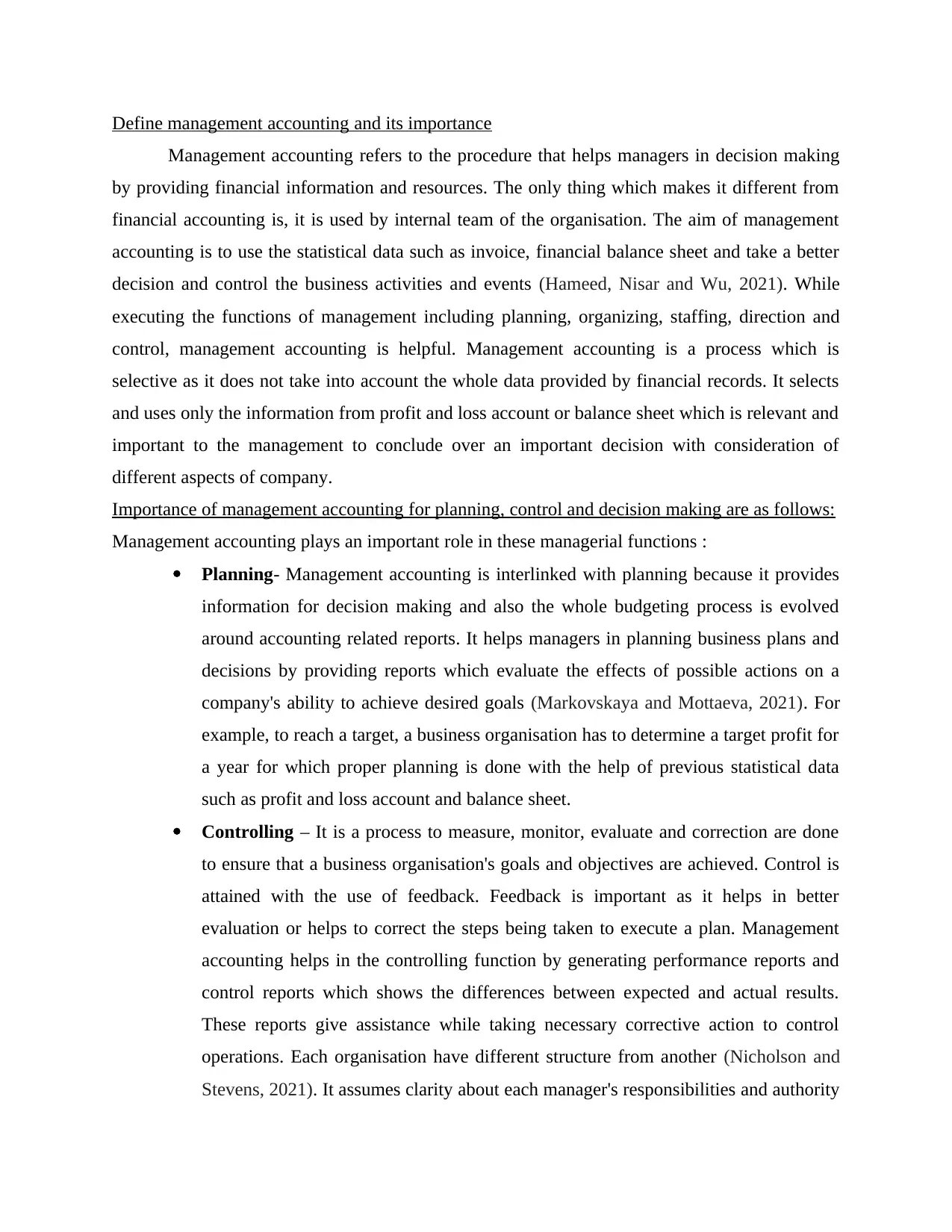
Define management accounting and its importance
Management accounting refers to the procedure that helps managers in decision making
by providing financial information and resources. The only thing which makes it different from
financial accounting is, it is used by internal team of the organisation. The aim of management
accounting is to use the statistical data such as invoice, financial balance sheet and take a better
decision and control the business activities and events (Hameed, Nisar and Wu, 2021). While
executing the functions of management including planning, organizing, staffing, direction and
control, management accounting is helpful. Management accounting is a process which is
selective as it does not take into account the whole data provided by financial records. It selects
and uses only the information from profit and loss account or balance sheet which is relevant and
important to the management to conclude over an important decision with consideration of
different aspects of company.
Importance of management accounting for planning, control and decision making are as follows:
Management accounting plays an important role in these managerial functions :
Planning- Management accounting is interlinked with planning because it provides
information for decision making and also the whole budgeting process is evolved
around accounting related reports. It helps managers in planning business plans and
decisions by providing reports which evaluate the effects of possible actions on a
company's ability to achieve desired goals (Markovskaya and Mottaeva, 2021). For
example, to reach a target, a business organisation has to determine a target profit for
a year for which proper planning is done with the help of previous statistical data
such as profit and loss account and balance sheet.
Controlling – It is a process to measure, monitor, evaluate and correction are done
to ensure that a business organisation's goals and objectives are achieved. Control is
attained with the use of feedback. Feedback is important as it helps in better
evaluation or helps to correct the steps being taken to execute a plan. Management
accounting helps in the controlling function by generating performance reports and
control reports which shows the differences between expected and actual results.
These reports give assistance while taking necessary corrective action to control
operations. Each organisation have different structure from another (Nicholson and
Stevens, 2021). It assumes clarity about each manager's responsibilities and authority
Management accounting refers to the procedure that helps managers in decision making
by providing financial information and resources. The only thing which makes it different from
financial accounting is, it is used by internal team of the organisation. The aim of management
accounting is to use the statistical data such as invoice, financial balance sheet and take a better
decision and control the business activities and events (Hameed, Nisar and Wu, 2021). While
executing the functions of management including planning, organizing, staffing, direction and
control, management accounting is helpful. Management accounting is a process which is
selective as it does not take into account the whole data provided by financial records. It selects
and uses only the information from profit and loss account or balance sheet which is relevant and
important to the management to conclude over an important decision with consideration of
different aspects of company.
Importance of management accounting for planning, control and decision making are as follows:
Management accounting plays an important role in these managerial functions :
Planning- Management accounting is interlinked with planning because it provides
information for decision making and also the whole budgeting process is evolved
around accounting related reports. It helps managers in planning business plans and
decisions by providing reports which evaluate the effects of possible actions on a
company's ability to achieve desired goals (Markovskaya and Mottaeva, 2021). For
example, to reach a target, a business organisation has to determine a target profit for
a year for which proper planning is done with the help of previous statistical data
such as profit and loss account and balance sheet.
Controlling – It is a process to measure, monitor, evaluate and correction are done
to ensure that a business organisation's goals and objectives are achieved. Control is
attained with the use of feedback. Feedback is important as it helps in better
evaluation or helps to correct the steps being taken to execute a plan. Management
accounting helps in the controlling function by generating performance reports and
control reports which shows the differences between expected and actual results.
These reports give assistance while taking necessary corrective action to control
operations. Each organisation have different structure from another (Nicholson and
Stevens, 2021). It assumes clarity about each manager's responsibilities and authority
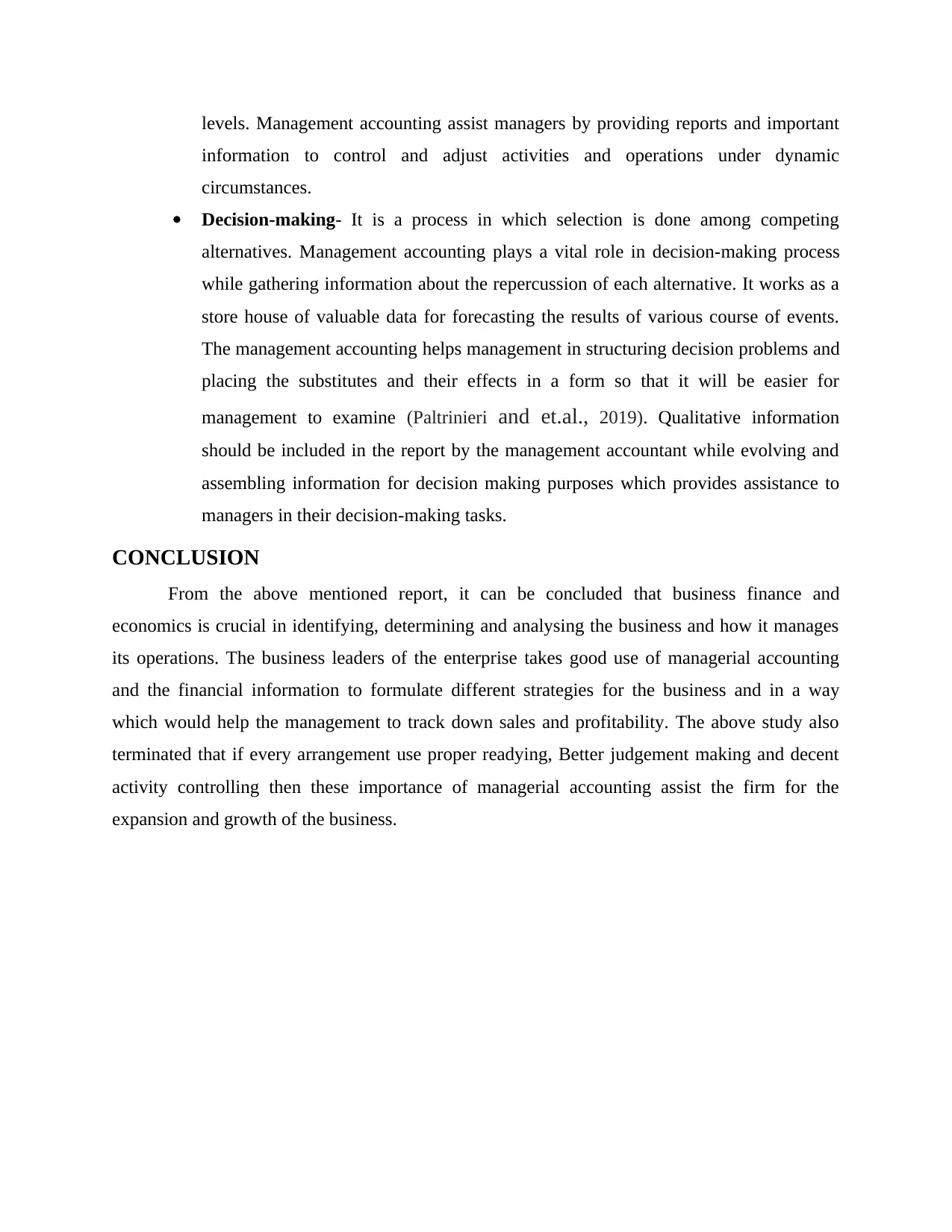
levels. Management accounting assist managers by providing reports and important
information to control and adjust activities and operations under dynamic
circumstances.
Decision-making- It is a process in which selection is done among competing
alternatives. Management accounting plays a vital role in decision-making process
while gathering information about the repercussion of each alternative. It works as a
store house of valuable data for forecasting the results of various course of events.
The management accounting helps management in structuring decision problems and
placing the substitutes and their effects in a form so that it will be easier for
management to examine (Paltrinieri and et.al., 2019). Qualitative information
should be included in the report by the management accountant while evolving and
assembling information for decision making purposes which provides assistance to
managers in their decision-making tasks.
CONCLUSION
From the above mentioned report, it can be concluded that business finance and
economics is crucial in identifying, determining and analysing the business and how it manages
its operations. The business leaders of the enterprise takes good use of managerial accounting
and the financial information to formulate different strategies for the business and in a way
which would help the management to track down sales and profitability. The above study also
terminated that if every arrangement use proper readying, Better judgement making and decent
activity controlling then these importance of managerial accounting assist the firm for the
expansion and growth of the business.
information to control and adjust activities and operations under dynamic
circumstances.
Decision-making- It is a process in which selection is done among competing
alternatives. Management accounting plays a vital role in decision-making process
while gathering information about the repercussion of each alternative. It works as a
store house of valuable data for forecasting the results of various course of events.
The management accounting helps management in structuring decision problems and
placing the substitutes and their effects in a form so that it will be easier for
management to examine (Paltrinieri and et.al., 2019). Qualitative information
should be included in the report by the management accountant while evolving and
assembling information for decision making purposes which provides assistance to
managers in their decision-making tasks.
CONCLUSION
From the above mentioned report, it can be concluded that business finance and
economics is crucial in identifying, determining and analysing the business and how it manages
its operations. The business leaders of the enterprise takes good use of managerial accounting
and the financial information to formulate different strategies for the business and in a way
which would help the management to track down sales and profitability. The above study also
terminated that if every arrangement use proper readying, Better judgement making and decent
activity controlling then these importance of managerial accounting assist the firm for the
expansion and growth of the business.
⊘ This is a preview!⊘
Do you want full access?
Subscribe today to unlock all pages.

Trusted by 1+ million students worldwide
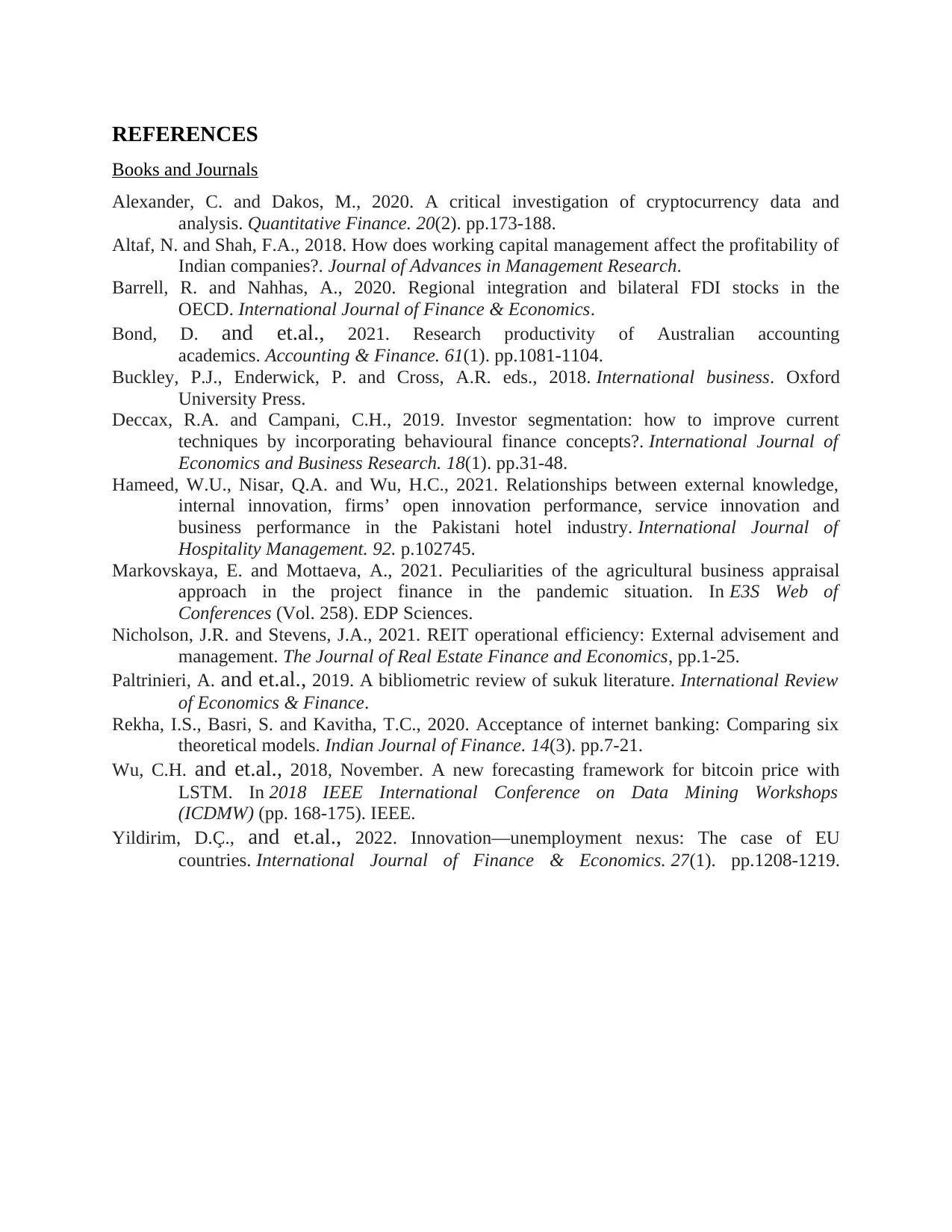
REFERENCES
Books and Journals
Alexander, C. and Dakos, M., 2020. A critical investigation of cryptocurrency data and
analysis. Quantitative Finance. 20(2). pp.173-188.
Altaf, N. and Shah, F.A., 2018. How does working capital management affect the profitability of
Indian companies?. Journal of Advances in Management Research.
Barrell, R. and Nahhas, A., 2020. Regional integration and bilateral FDI stocks in the
OECD. International Journal of Finance & Economics.
Bond, D. and et.al., 2021. Research productivity of Australian accounting
academics. Accounting & Finance. 61(1). pp.1081-1104.
Buckley, P.J., Enderwick, P. and Cross, A.R. eds., 2018. International business. Oxford
University Press.
Deccax, R.A. and Campani, C.H., 2019. Investor segmentation: how to improve current
techniques by incorporating behavioural finance concepts?. International Journal of
Economics and Business Research. 18(1). pp.31-48.
Hameed, W.U., Nisar, Q.A. and Wu, H.C., 2021. Relationships between external knowledge,
internal innovation, firms’ open innovation performance, service innovation and
business performance in the Pakistani hotel industry. International Journal of
Hospitality Management. 92. p.102745.
Markovskaya, E. and Mottaeva, A., 2021. Peculiarities of the agricultural business appraisal
approach in the project finance in the pandemic situation. In E3S Web of
Conferences (Vol. 258). EDP Sciences.
Nicholson, J.R. and Stevens, J.A., 2021. REIT operational efficiency: External advisement and
management. The Journal of Real Estate Finance and Economics, pp.1-25.
Paltrinieri, A. and et.al., 2019. A bibliometric review of sukuk literature. International Review
of Economics & Finance.
Rekha, I.S., Basri, S. and Kavitha, T.C., 2020. Acceptance of internet banking: Comparing six
theoretical models. Indian Journal of Finance. 14(3). pp.7-21.
Wu, C.H. and et.al., 2018, November. A new forecasting framework for bitcoin price with
LSTM. In 2018 IEEE International Conference on Data Mining Workshops
(ICDMW) (pp. 168-175). IEEE.
Yildirim, D.Ç., and et.al., 2022. Innovation—unemployment nexus: The case of EU
countries. International Journal of Finance & Economics. 27(1). pp.1208-1219.
Books and Journals
Alexander, C. and Dakos, M., 2020. A critical investigation of cryptocurrency data and
analysis. Quantitative Finance. 20(2). pp.173-188.
Altaf, N. and Shah, F.A., 2018. How does working capital management affect the profitability of
Indian companies?. Journal of Advances in Management Research.
Barrell, R. and Nahhas, A., 2020. Regional integration and bilateral FDI stocks in the
OECD. International Journal of Finance & Economics.
Bond, D. and et.al., 2021. Research productivity of Australian accounting
academics. Accounting & Finance. 61(1). pp.1081-1104.
Buckley, P.J., Enderwick, P. and Cross, A.R. eds., 2018. International business. Oxford
University Press.
Deccax, R.A. and Campani, C.H., 2019. Investor segmentation: how to improve current
techniques by incorporating behavioural finance concepts?. International Journal of
Economics and Business Research. 18(1). pp.31-48.
Hameed, W.U., Nisar, Q.A. and Wu, H.C., 2021. Relationships between external knowledge,
internal innovation, firms’ open innovation performance, service innovation and
business performance in the Pakistani hotel industry. International Journal of
Hospitality Management. 92. p.102745.
Markovskaya, E. and Mottaeva, A., 2021. Peculiarities of the agricultural business appraisal
approach in the project finance in the pandemic situation. In E3S Web of
Conferences (Vol. 258). EDP Sciences.
Nicholson, J.R. and Stevens, J.A., 2021. REIT operational efficiency: External advisement and
management. The Journal of Real Estate Finance and Economics, pp.1-25.
Paltrinieri, A. and et.al., 2019. A bibliometric review of sukuk literature. International Review
of Economics & Finance.
Rekha, I.S., Basri, S. and Kavitha, T.C., 2020. Acceptance of internet banking: Comparing six
theoretical models. Indian Journal of Finance. 14(3). pp.7-21.
Wu, C.H. and et.al., 2018, November. A new forecasting framework for bitcoin price with
LSTM. In 2018 IEEE International Conference on Data Mining Workshops
(ICDMW) (pp. 168-175). IEEE.
Yildirim, D.Ç., and et.al., 2022. Innovation—unemployment nexus: The case of EU
countries. International Journal of Finance & Economics. 27(1). pp.1208-1219.
1 out of 10
Related Documents
Your All-in-One AI-Powered Toolkit for Academic Success.
+13062052269
info@desklib.com
Available 24*7 on WhatsApp / Email
![[object Object]](/_next/static/media/star-bottom.7253800d.svg)
Unlock your academic potential
Copyright © 2020–2025 A2Z Services. All Rights Reserved. Developed and managed by ZUCOL.



